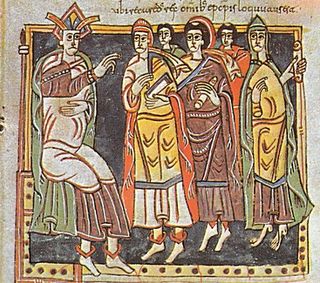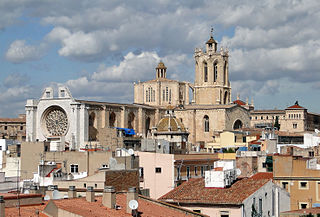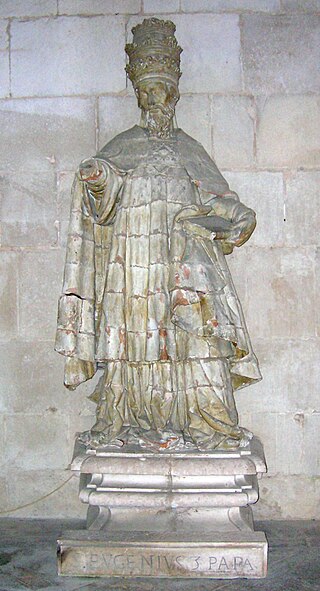This article relies largely or entirely on a single source .(December 2023) |
Eugenius I (sometimes Eugene; died 647) was Archbishop of Toledo from 636 to 646. He is also known as an astronomer and astronomical mathematician.
This article relies largely or entirely on a single source .(December 2023) |
Eugenius I (sometimes Eugene; died 647) was Archbishop of Toledo from 636 to 646. He is also known as an astronomer and astronomical mathematician.
Eugenius was a disciple of Helladius in the monastery of Agali. In 1636, he succeeded Justus, another disciple of Helladius, as archbishop of Toledo.
At this period, under the Visigothic Kingdom, the councils of Toledo were national diets convoked by the monarch, attended by lay lords; they regulated, to some extent, not only spiritual but temporal affairs.
Of these councils Eugenius presided at the Fifth Council of Toledo, convoked in 636 by King Chintila to confirm his elevation to the throne; he assisted at the sixth, convoked by the same king to take precautions against the disorders of royal elections.
This council, contrary to the principles later put in practice by Ildephonsus, banished all Jews who did not embrace Catholicism.
Eugenius attended the Seventh Council of Toledo, which was summoned by King Chindaswinth and decreed that the bishops of Toledo should reside one month every year in that city.

Isidore of Seville was a Hispano-Roman scholar, theologian, and archbishop of Seville. He is widely regarded, in the words of 19th-century historian Montalembert, as "the last scholar of the ancient world".
Year 636 (DCXXXVI) was a leap year starting on Monday of the Julian calendar. The denomination 636 for this year has been used since the early medieval period, when the Anno Domini calendar era became the prevalent method in Europe for naming years.

From the 5th century to the 7th century AD, about thirty synods, variously counted, were held at Toledo in what would come to be part of Spain. The earliest, directed against Priscillianism, assembled in 400. The "third" synod of 589 marked the epoch-making conversion of King Reccared from Arianism to Orthodox Chalcedonian Christianity. The "fourth", in 633, probably under the presidency of the noted Isidore of Seville, regulated many matters of discipline and decreed uniformity of liturgy throughout the kingdom. The Britonia of Galicia accepted the Latin liturgical rite. The "twelfth" council in 681 assured to the archbishop of Toledo the primacy of Hispania. As nearly one hundred early canons of Toledo found a place in the Decretum Gratiani, they exerted an important influence on the development of ecclesiastical law.

Sisenand was the Visigothic King of Hispania, Septimania and Galicia from 631 to 636.

Chintila was a Visigothic King of Hispania, Septimania and Galicia from 636. He succeeded Sisenand and reigned until he died of natural causes, ruling over the fifth and sixth provisional Councils of Toledo. He wrote poetry as well. He was succeeded by his son from an unknown wife, Tulga.

The Archdiocese of Toledo is a Latin Church archdiocese of the Catholic Church located in Spain. They are also the Primates of Spain. It was, according to tradition established in the 1st century by James the Great and was elevated to an archdiocese in 313 after the Edict of Milan. The incumbent Metropolitan Archbishop also bears the title Primate of Spain and since 1937 the title General Vicar of the Armies
The Tenth Council of Toledo was summoned to meet in Toledo on 1 December 656 by King Reccesuinth of Hispania.

The Archdiocese of Tarragona is a Latin Church ecclesiastical territory located in north-eastern Spain, in the province of Tarragona, part of the autonomous community of Catalonia. The archdiocese heads the ecclesiastical province of Tarragona, having Metropolitan authority over the suffragan dioceses of Girona, Lleida, Solsona, Tortosa, Urgell and Vic.
The Fifth Council of Toledo was convoked by King Chintila and opened on 30 June 636 in the church of Saint Leocadia in Toledo. It was attended by twenty two bishops and two episcopal representatives. The bishops of Narbonensis were absent for political reasons. It primarily dealt with political matters.
The Sixth Council of Toledo was the second council convoked by King Chintila and opened on 9 January 638 in the church of St. Leocadia in Toledo. It was attended by fifty three bishops, including those from Narbonensis who had not participated in the prior council for political reasons. The council was thus a reunion of the whole church of Spain. Its primary purpose was to reaffirm the decrees of the Fifth Council of 636 and to restore internal peace.

The diocese of Auxerre is a former French Roman Catholic diocese. Its historical episcopal see was in the city of Auxerre in Burgundy, now part of eastern France. Currently the non-metropolitan Archbishop of Sens, ordinary of the diocese of Sens and Auxerre, resides in Auxerre.

The Archdiocese of Burgos is Latin Metropolitan sees of the Catholic Church in Spain.
Eugenius was a 4th-century Roman emperor.
Reims, located in the north-east of modern France, hosted several councils or synods in the Roman Catholic Church. These councils did not universally represent the church and are not counted among the official ecumenical councils.
Saint Eugenius II, sometimes called Eugenius the Younger as the successor of Eugenius I, was Archbishop of Toledo from 647 until his death.

In 1148, a Council of Reims was called by Pope Eugene III to consider a variety of issues for the Church. Originally the summons to the council went out in October 1147 and it was supposed to be held in February 1148 at Trier, but conditions there were such that it was moved to Reims. A number of the bishops and other Churchmen who had been convoked did not attend and Eugene suspended many of the non-attendees, excepting the other Churchmen of Italy, who were excused. The council convened on 21 March 1148 and is said to have lasted 11 days in total, which would give an end date of 1 April 1148. However, it is possible that it was shorter, given that the large increase in the population of Reims would have strained the town's resources.
Domenec Ram y Lanaja was an aragonese politician and diplomat who was Viceroy of Sicily in 1415–1419, succeeding Prince John of Aragon, later King John II of Aragon.
The monastery of Agali, probably dedicated to Saints Cosmas and Damian, was founded around 590/600 in the vicinity of Toledo. It probably lay along the important road from Complutum to Gaul. Several of its monks became bishops of Toledo during the seventh century.

Helladius, Eladio or Elladio of Toledo was a Christian archbishop. Born into a Visigothic noble family in Spain, he initially held important positions at court but was attracted to the monastic life and took his vows at the Agali monastery. He became its abbot and later archbishop of Toledo. The Roman Martyrology gives his feast as 18 February.
The Synod of Worms of May 868 was a council of the church in East Francia, convoked by King Louis the German at the request of Pope Nicholas I. It condemned the Synod of Constantinople of 867 as heretical and condemned Great Moravia for rebelling against Louis.